Woodpeckers in Pennsylvania are some of the most fascinating and colorful birds found across the state’s diverse forests and woodlands. Known for their distinctive drumming sounds and striking plumage, these birds play a vital role in the ecosystem by controlling insect populations and creating nesting cavities that benefit other wildlife. Observing woodpeckers in Pennsylvania offers a unique opportunity to connect with nature and appreciate its complexity.
This article highlights 9 common woodpecker species in Pennsylvania, providing detailed descriptions and key identification tips. From the small and agile Downy Woodpecker to the impressive and bold Pileated Woodpecker, each species has unique features and behaviors that make them stand out. Information about their habitats and feeding patterns will help pinpoint the best places and times to encounter these birds.
Exploring woodpeckers in Pennsylvania reveals much about the state’s natural heritage and forest health. These birds can be spotted in various environments—from dense woodlands to urban parks—showcasing their adaptability and importance in local ecosystems. Prepare to learn about these remarkable birds and enhance your understanding of Pennsylvania’s wildlife.
Common Woodpeckers Found in Pennsylvania
Downy Woodpecker (Picoides pubescens)
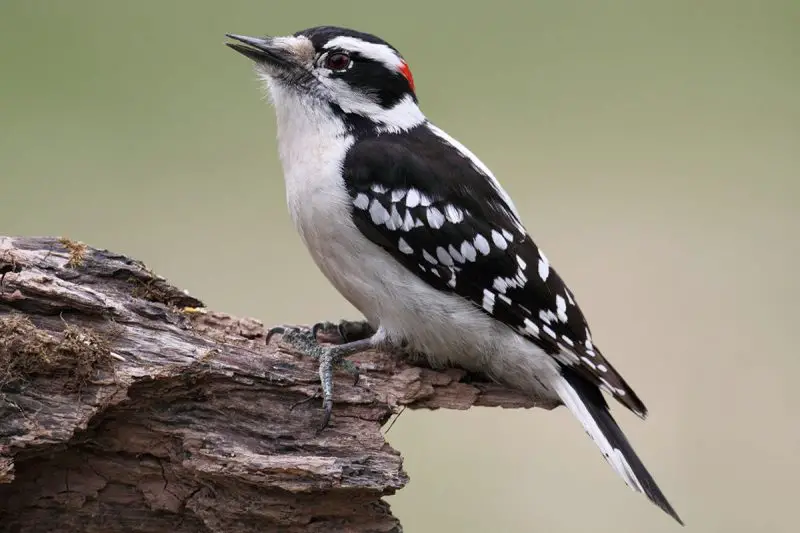
The Downy Woodpecker is the smallest woodpecker species in North America, measuring approximately 15 to 18 centimeters in length. It is easily recognizable by its distinctive black and white plumage, with a predominantly white underside and a patterned black and white back. Males feature a small red patch on the back of their heads, which is absent in females. Its short, chisel-like bill is proportional to its small size, making it distinguishable from similar species.
In terms of behavior, the Downy Woodpecker is quite active and agile, often seen climbing tree trunks and branches in search of food. It primarily feeds on insects, such as beetle larvae and ants, but also consumes seeds and berries, especially during the winter months when insects are scarce. Its foraging often involves tapping and pecking at wood to uncover hidden prey beneath bark or in decaying wood.
This species inhabits a variety of wooded environments, including deciduous forests, orchards, parks, and suburban areas with mature trees. It favors areas with plenty of dead or dying wood, which provide ideal feeding grounds and nesting sites. The Downy Woodpecker is widespread across Pennsylvania, where it can be observed year-round, adapting well to both rural and urban landscapes.
Distribution-wise, the Downy Woodpecker is common throughout the eastern and central United States, including Pennsylvania. It thrives in mixed woodlands as well as in residential areas with suitable tree cover, making it one of the most frequently encountered woodpeckers in the region.
Hairy Woodpecker (Picoides villosus)
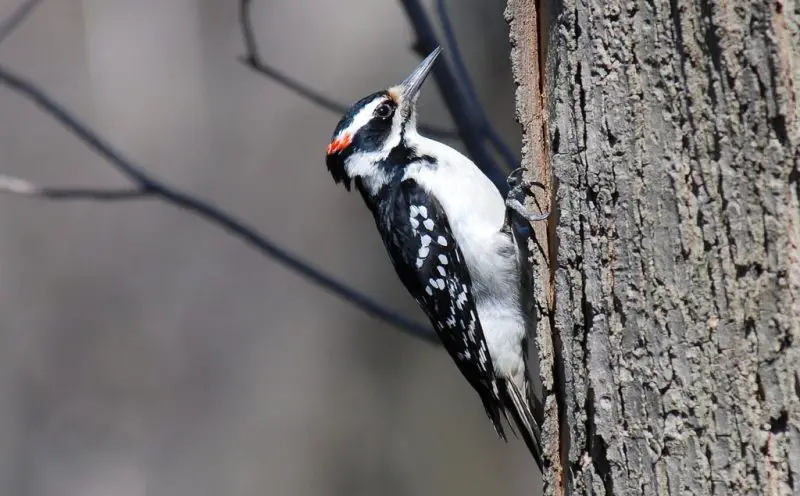
The Hairy Woodpecker is noticeably larger than the Downy Woodpecker, measuring between 20 to 25 centimeters in length. It shares similar black and white coloration but can be distinguished by its longer, more robust bill that is roughly the same length as its head. The plumage includes a white underside, black wings with white spots, and a black and white striped head. Males display a small red patch on the back of their head, which females lack.
Behaviorally, the Hairy Woodpecker is a strong drumming bird, using its powerful bill to hammer into tree trunks and branches to find insects, primarily beetles and their larvae, ants, and other wood-boring insects. It also feeds on seeds and occasionally fruits. This woodpecker is known for its ability to forage on larger trees compared to the smaller Downy Woodpecker.
Its preferred habitat includes mature forests with large trees, especially hardwood forests and mixed woodlands. It can also be found in wooded suburban areas but generally avoids smaller patches of trees. Hairy Woodpeckers nest in cavities they excavate themselves in dead or dying trees.
The species is widespread in Pennsylvania and throughout much of North America, especially in forests with abundant large trees. It is common in state parks and forested areas, where it plays an important role in controlling insect populations.
Red-bellied Woodpecker (Melanerpes carolinus)
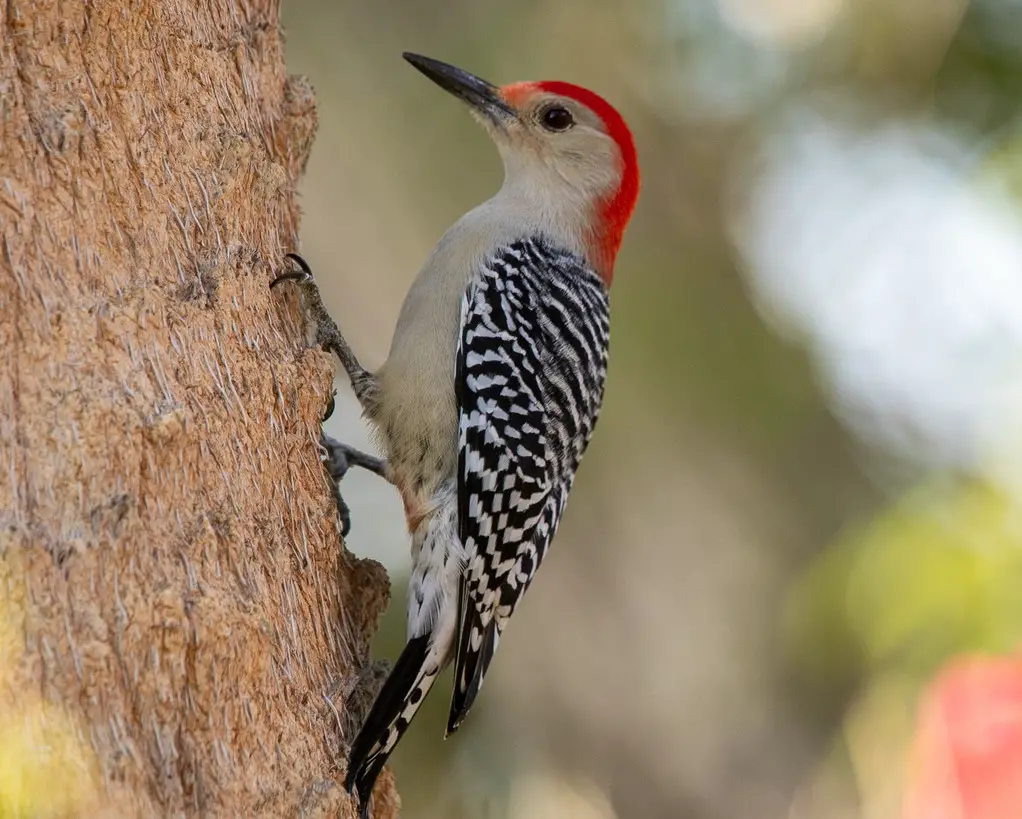
The Red-bellied Woodpecker is medium-sized, measuring around 22 to 26 centimeters in length. Despite its name, the red coloration on its belly is quite faint and often hard to notice. Its most striking feature is the vibrant red cap and nape, which extends from the forehead to the back of the neck in males, while females show red only on the nape. The back is boldly patterned with black and white horizontal stripes, and the underparts are pale gray or whitish.
This woodpecker is quite vocal and active, frequently heard before it is seen. It forages on tree trunks and branches for insects, but also feeds heavily on nuts, seeds, and fruits. It is known for caching food, storing nuts in crevices to eat later. The Red-bellied Woodpecker is adaptable and often visits backyard feeders, especially those offering suet and peanuts.
Its habitat ranges from deciduous and mixed forests to suburban and urban areas with large trees. It is commonly found in Pennsylvania woodlands, parks, and residential neighborhoods, thriving in both natural and human-altered landscapes.
The distribution of the Red-bellied Woodpecker extends through the eastern United States, including Pennsylvania, where it has become increasingly common in urban environments due to its adaptability and varied diet.
Red-headed Woodpecker (Melanerpes erythrocephalus)

The Red-headed Woodpecker is easily identifiable by its striking appearance, with a bright red head, neck, and throat contrasting sharply with its white body and black wings. It measures between 21 to 26 centimeters in length, making it a medium-sized woodpecker. The wings show a distinctive pattern of solid black and white, creating a bold visual contrast that makes this species unmistakable.
This species exhibits diverse feeding behavior, catching insects in flight, foraging on trees for beetles and larvae, and consuming a variety of fruits and nuts. It is known for its habit of storing food, especially acorns, in crevices for later consumption. The Red-headed Woodpecker is also territorial and often defends its nesting cavity aggressively.
Red-headed Woodpeckers prefer open woodland habitats, such as oak savannas, forest edges, and areas with scattered trees and open fields. They are also found in old orchards and parks. In Pennsylvania, this species is less common than some other woodpeckers but can still be seen in suitable open forest habitats and agricultural areas with mature trees.
The Red-headed Woodpecker’s range covers much of the eastern and central United States. Though its population has declined in some areas due to habitat loss, conservation efforts have helped stabilize numbers, and it remains a captivating sight for birdwatchers in Pennsylvania.
Northern Flicker (Colaptes auratus)

The Northern Flicker is a distinctive woodpecker species with a predominantly brown body covered in numerous black spots. Its underparts display a yellow or reddish hue, depending on the subspecies, which helps distinguish between different regional populations. The head coloration varies by gender, with males often sporting a red patch on the back of the head, while females have a more subdued gray or brownish head. This bird’s size ranges from about 28 to 31 centimeters, making it larger than many other woodpeckers.
Unlike many woodpeckers that spend much time on tree trunks, Northern Flickers are frequently seen on the ground where they forage for ants and beetles, their primary food sources. They also feed on fruits and seeds and use their long, barbed tongue to extract insects from crevices. Their foraging behavior is unique as they often flick away leaf litter to uncover prey, which is how they got their name.
Northern Flickers inhabit open woodlands, parks, gardens, and forest edges, preferring areas that offer both open ground for feeding and trees for nesting and roosting. They are adaptable birds and can often be seen in suburban yards and city parks, where mature trees and open lawns coexist.
In Pennsylvania, the Northern Flicker is a common year-round resident, particularly prevalent in open and semi-open habitats. Its broad range extends across much of North America, making it one of the most widespread and recognizable woodpecker species in the region.
Yellow-bellied Sapsucker (Sphyrapicus varius)
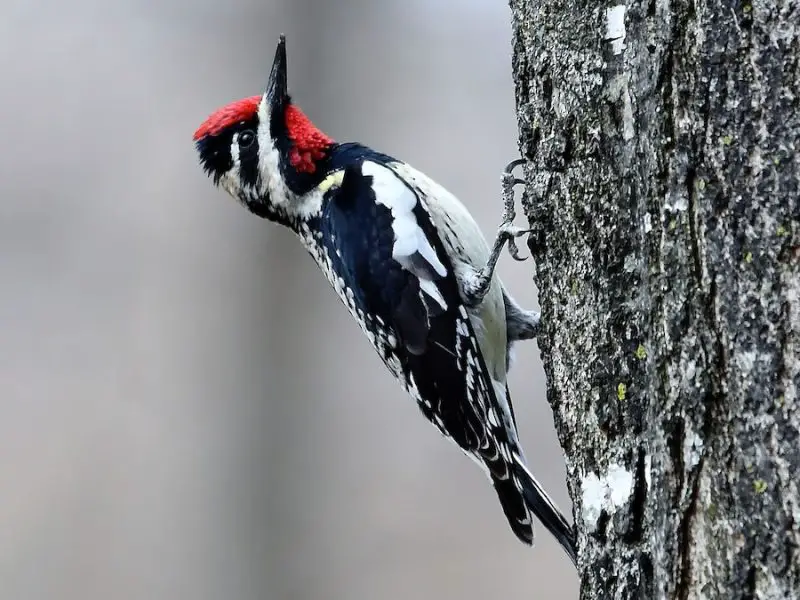
The Yellow-bellied Sapsucker is a small to medium-sized woodpecker measuring approximately 18 to 22 centimeters in length. Its most distinctive feature is the bright red patch on its head, accompanied by bold black markings on the face and throat. The bird’s belly shows a pale yellow wash, while the back and wings are mottled with black and white patterns. Both males and females share similar coloration, though males typically have a red throat patch, which females lack.
This species is well-known for its specialized feeding behavior: it drills orderly rows of small holes into the bark of trees to access sap, which it then consumes along with insects attracted to the sap flow. This sap-drilling activity creates visible “sap wells” that can persist on trees for weeks. The Yellow-bellied Sapsucker primarily feeds on tree sap, insects, and occasionally fruit, making it unique among woodpeckers.
Habitually, the Yellow-bellied Sapsucker prefers mixed forests, especially those near streams or wetlands where aspen, birch, and maple trees are abundant. It nests in tree cavities and requires a habitat with mature trees that can support its sap extraction habits. During migration, it may also be found in parks and wooded urban areas.
In Pennsylvania, this woodpecker is a common migrant and winter visitor, appearing most frequently in the fall and spring during migration seasons. Its breeding range extends further north, but many birds pass through or overwinter in the state, especially in forested areas rich in sap-producing trees.
Pileated Woodpecker (Dryocopus pileatus)

The Pileated Woodpecker is the largest woodpecker species in North America, measuring about 40 to 49 centimeters in length. Its striking appearance includes predominantly black plumage with a bold, bright red crest on top of its head. When in flight, the bird reveals distinctive white underwing patches that contrast sharply with the black feathers. The face also shows some white markings, making this species quite dramatic and unmistakable.
This woodpecker is known for its powerful drumming and deep, loud calls that echo through large forests. It excavates enormous rectangular holes in dead or decaying trees to forage for carpenter ants, beetle larvae, and other insects hidden beneath the bark. Due to its large size and strong bill, it can tear through wood more aggressively than smaller species, often leaving behind noticeable signs of feeding.
Pileated Woodpeckers inhabit mature, extensive forests with large, old trees, including deciduous and mixed woodlands. They prefer undisturbed, primary forests but can occasionally be found in well-established parks and large wooded areas near human settlements. Because they favor dense forest interiors, they are often elusive and less frequently seen compared to other woodpeckers.
In Pennsylvania, the Pileated Woodpecker is a year-round resident, primarily occupying large forest tracts across the state. Although not rare, it can be difficult to spot due to its preference for deep forest habitats. Birdwatchers value encounters with this majestic species for its impressive size and characteristic calls.
American Three-toed Woodpecker (Picoides dorsalis)
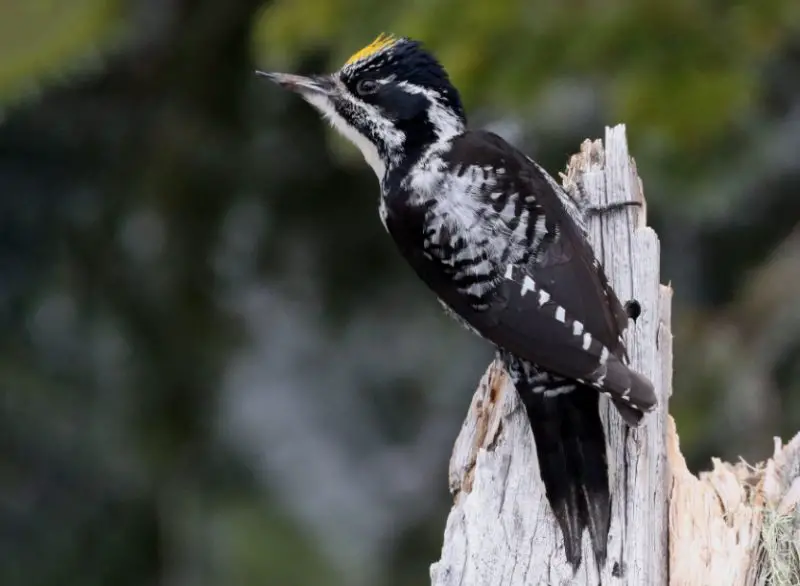
The American Three-toed Woodpecker is a rare and elusive species in Pennsylvania, mostly found further north in boreal forests. Measuring approximately 18 to 21 centimeters, it is smaller than some of the other large woodpeckers but distinctive due to having only three toes on each foot, unlike the typical four found in most other woodpeckers. Its plumage features a mix of black and white, with white spots or bars contrasting against a black background.
Because of its rarity and preference for remote northern forests, this woodpecker is seldom seen in Pennsylvania except on rare occasions. It typically inhabits coniferous forests, especially areas affected by recent insect outbreaks or fires, where dead and dying trees provide ample feeding and nesting opportunities.
The American Three-toed Woodpecker feeds primarily on wood-boring insects and their larvae, often excavating deep into tree bark to reach its prey. It also occasionally consumes sap and berries. Its foraging behavior is similar to other woodpeckers but specialized for the colder, boreal environments where it is more commonly found.
While almost absent from Pennsylvania, this species has a broader range extending across Canada and into parts of the northern United States. Sightings in Pennsylvania are considered rare and are typically of great interest to birders seeking uncommon species.
Black-backed Woodpecker (Picoides arcticus)
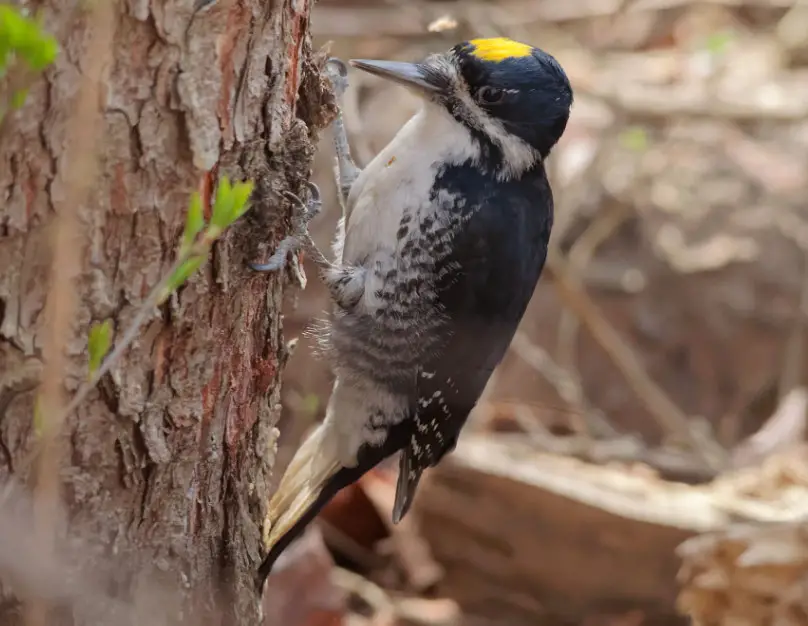
The Black-backed Woodpecker is another rare woodpecker species in Pennsylvania, mainly inhabiting northern boreal forests. It is easily identified by its mostly black body and striking red patch on the crown of its head. The black plumage covers the back and wings, giving it its name, while its underparts are a lighter gray or white. The size ranges from about 21 to 24 centimeters, placing it in the medium woodpecker category.
This species favors habitats affected by wildfires or insect outbreaks, where freshly dead trees provide ideal feeding sites. The Black-backed Woodpecker feeds almost exclusively on wood-boring beetle larvae found beneath the bark of dying or dead conifers. It uses its strong bill to peel back bark and extract insects, playing a crucial role in forest ecosystem health.
In Pennsylvania, the Black-backed Woodpecker is exceedingly rare and mostly confined to the northernmost parts of the state where suitable boreal habitat exists. Due to its specialized habitat needs, it is seldom seen and generally considered a species of conservation concern in more southern regions.
The Black-backed Woodpecker’s broader range includes boreal forests across Canada and the northern United States. Its reliance on disturbed forest areas makes it a unique indicator of forest health and regeneration dynamics in its native habitat.
Best Times and Places to See Woodpeckers in Pennsylvania
The best time to see woodpeckers in Pennsylvania is during the spring and early summer when many species are actively breeding and drumming to establish their territories. During this period, woodpeckers are more vocal and visible as they search for food to feed their young. Fall can also be a good season to spot them, as they forage heavily to prepare for winter. While woodpeckers remain in Pennsylvania year-round, winter sightings may be less frequent, but feeding stations can attract species like Downy and Red-bellied Woodpeckers even in colder months.
Ideal locations to observe woodpeckers include mature forests, especially mixed hardwood and deciduous woodlands, which offer abundant food sources and nesting sites. Pennsylvania’s state parks such as Ricketts Glen, Cook Forest, and Michaux State Forest are excellent places for woodpecker watching. Additionally, suburban neighborhoods with large trees, orchards, and wooded parks often attract common species, making birdwatching accessible even near cities. Open woodland edges, forest clearings, and areas near streams also provide great habitats for different woodpecker species.
Early mornings and late afternoons are the most active times of day for woodpeckers, as they feed and communicate during these cooler hours. Bringing binoculars and remaining quiet while listening for their distinctive drumming and calls can greatly increase your chances of spotting these fascinating birds. Exploring these times and places will help you enjoy the vibrant presence of woodpeckers in Pennsylvania’s diverse landscapes.

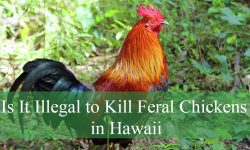
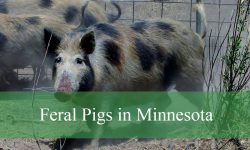


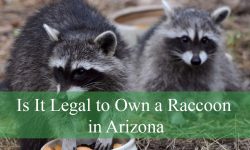
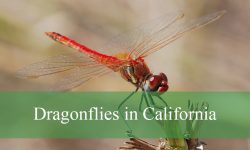
Thank you for the pictures and information on woodpeckers. Lots of good facts briefly put.